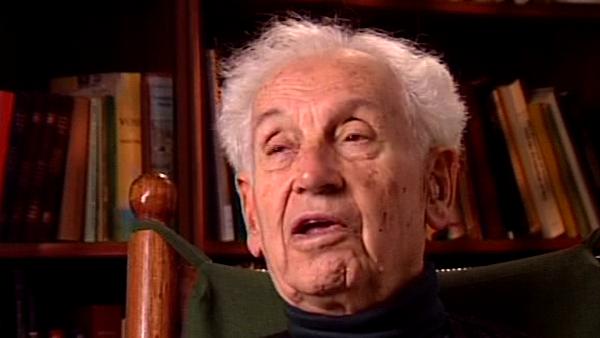NEXT STORY

Changing ideologies: essentialism
RELATED STORIES

NEXT STORY

Changing ideologies: essentialism
RELATED STORIES


|
Views | Duration | |
|---|---|---|---|
| 131. Distinguishing Darwin's many theories | 363 | 02:18 | |
| 132. Darwin's theories on evolution | 349 | 05:02 | |
| 133. Darwin: beliefs and achievements | 246 | 04:36 | |
| 134. Problems of the philosophy of biology | 345 | 02:24 | |
| 135. Differences between living organisms and inanimate matter | 401 | 02:52 | |
| 136. Creating a historical narrative | 694 | 03:33 | |
| 137. Writing Toward a New Philosophy of Biology and... | 190 | 03:49 | |
| 138. Three theories of evolution | 360 | 03:45 | |
| 139. Changing ideologies: essentialism | 786 | 02:30 | |
| 140. Changing ideologies: reductionism | 335 | 05:27 |


If we go back through the history of evolutionary thinking and actually it goes back… right back to the Greeks, but let's just go as far back as the 18th century, we find that basically there have been only three real theories of evolution. The first one is 'transmutationism', which is the essentialistic answer to the problem of evolution which means that all changes… evolutionary changes are due to mutations. Hence the name transmutations, mutations that is, big jumps, big saltations, the creation of new types because transmutationism is based on essentialism and typology, and any change that can happen only through the production of new types. Now, that's the first concept of evolution and that didn't die with the proposal of The Origin of Species in 1859. For instance, TH Huxley, Harvard's… Darwin's friend, was a transmutationist and the last three representatives were the German geneticist… German-American geneticist, [Richard] Goldschmidt, who believed in major steps, what he called 'hopeful monsters'; the botanist Willis who said that all new species originate by a single step; and finally the palaeontologist Schindewolf who… based the whole palaeontological history on transmutationism. That's the first one of the three. The second one is transformationism. That means the gradual change, this was a, so to speak, a softening of typological thinking. Yes, at any one given time a type is… is constant but in the course of time a type can change. And of course the… this is where the word ‘evolution’ was first used, it was used for the development of an egg into an adult. It is evolving, it's transforming from the egg, the fertilized egg, to the adult individual, and so the definition of transformationism is that it's a belief in evolution based on a gradual change of a particular object… of a particular entity. Such transformations, of course, we have in astronomy, changes in stars from one kind of star to another kind, we have it in a somewhat broader sense of the word in geology with the building up of a mountain range by tectonic forces and then the gradual erosion again by subsequent thing. So, transformationism… the typical example, of course, is [Jean-Baptiste] Lamarck's evolutionary theory where his little infusorians gradually evolved into the higher organisms, plants and mammals and ultimately man. Now, that's the second of the evolutionary theories. And the third was Darwin's variational evolution which said that at any given time you have variable populations and by the forces of selection and the genetic forces of mutation and so forth, these variable populations gradually change from generation to generation, and that is the evolution that Darwin believes in, and that is the evolution which the modern evolutionist has accepted.
The late German-American biologist Ernst Mayr (1904-2005) was a leading light in the field of evolutionary biology, gaining a PhD at the age of 21. He was also a tropical explorer and ornithologist who undertook an expedition to New Guinea and collected several thousand bird skins. In 1931 he accepted a curatorial position at the American Museum of Natural History. During his time at the museum, aged 37, he published his seminal work 'Systematics and Origin of the Species' which integrated the theories of Darwin and Mendel and is considered one of his greatest works.
Title: Three theories of evolution
Listeners: Walter J. Bock
Walter J. Bock is Professor of Evolutionary Biology at Columbia University. He received his B.Sc. from Cornell and his M.A. and Ph.D. from Harvard. His research lies in the areas of organismal and evolutionary biology, with a special emphasis on functional and evolutionary morphology of the skeleto-muscular system, specifically the feeding apparatus of birds.
Tags: The Origin of Species, 1859, Harvard University, TH Huxley, Charles Darwin, Richard Goldschmidt, Jean-Baptiste Lamarck
Duration: 3 minutes, 46 seconds
Date story recorded: October 1997
Date story went live: 24 January 2008